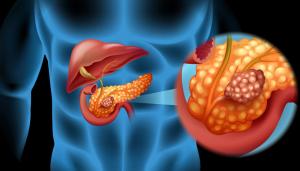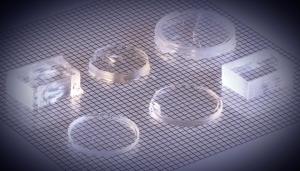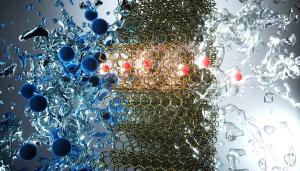LAB REPORT
Science and Technology Making Headlines
Dec. 18, 2020


By looking at satellite measurements of temperature changes in the lower layer of Earth’s atmosphere, LLNL scientists found that climate models may have overestimated the decade-to-decade natural variability of temperature.
Satellite view
By looking at satellite measurements of temperature changes in the lower layer of Earth’s atmosphere, Lawrence Livermore scientists found that climate models may have overestimated the decade-to-decade natural variability of temperature.
LLNL statistician Giuliana Pallotta and climate scientist Benjamin Santer created a statistical framework to comprehensively assess the significance of differences between simulated and observed natural variability in mid- to upper tropospheric temperature (TMT). The troposphere is the lowest region of the atmosphere, extending from the Earth's surface to a height of about 4 to 12 miles, depending on latitude and season.
The team found that in current and earlier generations of climate models, the natural decade-to-decade variability of tropospheric temperature is systematically too large relative to estimates of natural variability obtained from satellites. Such an overestimate of natural “climate noise” would make it more difficult to identify a human-caused tropospheric warming signal.

A team of scientists used math and physics to determine the trajectory of a spiraling football.
Researchers go long on perfect throw
Researchers including Lawrence Livermore’s Willy Moss have revealed the secret to the perfect football throw and it turns out the path taken by the ball’s nose is not what they had expected.
The team used math and physics to figure out why the tip of a spiraling football follows the ball’s path. And it all comes down to the similarity of a spiraling football to a spinning top or gyroscope. A gyroscope is often a wheel or disk spinning rapidly about an axis that is not fixed; its axis is free to change direction.
“What is cool about gyroscopes,” Moss said, “is that once they start spinning, they want to keep their spin axis in the same direction.”
A football has a spin axis, too. It’s the imaginary line that goes longways through the football. It’s also the imaginary line around which the ball spins. As a football leaves a quarterback’s hand, the ball’s spin axis points upward. By the time the receiver catches the ball, that spin axis points now down. Basically, the spin axis has followed the trajectory, or path, of the football itself.


The pancreas is essential for secreting enzymes that help digest food and is critical in regulating blood sugar levels. Pancreatic cancer, while rare, is extremely deadly; tumors are difficult to excise surgically and therapies are mostly ineffective.
Blocking and tackling pancreatic cancer
LLNL scientists and collaborators have identified a protein that when removed from the body may help pancreatic cancer patients live longer.
Pancreatic cancer is one of the most lethal forms of the disease and has the lowest survival rate. Because the tumors are solid, many modern chemotherapies to destroy the tumor do not work.
Pancreatic cancer is on course to be the second-leading cause of cancer-related death in the country, according to the American Cancer Society, with most people surviving less than a year after diagnosis. Therapies approved to treat the cancer are poorly effective and extend survival by only a few months.
In mice subjects that were genetically engineered to contain pancreatic tumors, the team found that removal of the cadherin (CDH11) gene significantly extended the survival rate of those mice. They also found that the main source of CDH11 were the cancer supporting fibroblasts.


An array of polished, 3D-printed gradient refractive lenses. Grid squares are 1 millimeter on each side.
GRIN and see it
Rather than the homogenous hunk of glass that makes up a conventional optical lens, a gradient-index (GRIN) optic has a refractive index that varies as a function of position inside the optic; this adds an extra degree of freedom that can simplify the shape of the optic or add extra capabilities.
Fabricating GRIN optics commonly involves diffusing a substance into glass to create the index gradient; this is a time-consuming and perhaps not entirely deterministic process. But researchers at Lawrence Livermore are using multimaterial 3D printing to create tailored GRIN optics that could make for better military specialized eyewear and virtual reality goggles.
The new technique could achieve a variety of conventional and unconventional optical functions in flat glass components, offering new optical design versatility in environmentally stable glass materials.


Small-diameter carbon nanotubes that pass through water molecules (red and white) and reject ions (blue). High water permeability of small-diameter nanotubes can enable advanced water desalination technologies. Illustration by Ella Maru Studios.
Tiny nanotubes worth their salt
Researchers at Lawrence Livermore have created carbon nanotube pores that, at just 0.8 nanometers, are so efficient at removing salt from water that they are comparable to commercial desalination membranes.
As the dominant technology for removing salt from water, reverse osmosis uses thin-film composite (TFC) membranes to separate water from the ions present in saline feed streams, but some fundamental performance issues remain. TFC membranes, however, are constrained by permeability-selectivity trade-offs and often have insufficient rejection of some ions and trace micropollutants, requiring additional purification stages that increase energy usage and cost.
Biological water channels, also known as aquaporins, provide a blueprint for the structures that could offer increased performance. They have an extremely narrow inner pore that squeezes water down to a single-file configuration that enables extremely high water permeability, with transport rates exceeding a billion water molecules per second through each pore.


LLNL Report takes a break
The Livermore Lab Report will take a break for the Christmas and New Year’s holidays. It will return Jan. 8.





